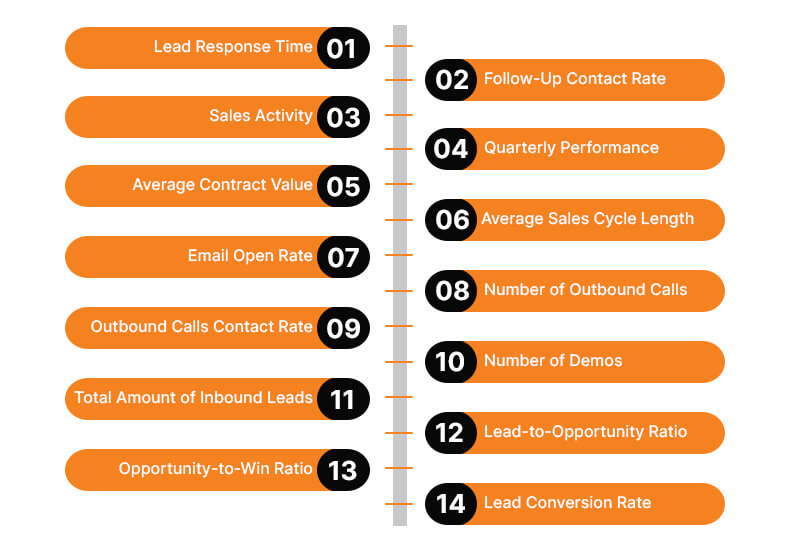Salesforce has become one of the most popular customer relationship management (CRM) platforms in recent years, enabling businesses of all sizes to streamline their sales, marketing, and customer service operations. To make the most of this powerful platform, many organizations turn to Salesforce development companies for their expertise in customizing and optimizing the platform to meet their needs. However, more than simply investing in Salesforce development is needed to guarantee success. It’s also essential to track key metrics to measure your Salesforce implementation’s return on investment (ROI).
That’s why in this article, we’ll explore some of the key metrics that Salesforce development companies recommend tracking to maximize ROI and get the most out of your Salesforce investment.
What is KPI in Salesforce?

In Salesforce, KPIs are the specific metrics that you can use to evaluate how well your sales and marketing activities are performing.
For example, some common KPIs in Salesforce include lead response time, follow-up contact rate, and average contract value. By tracking these metrics, you can see how well your sales team is doing at responding to leads, how effective your follow-up strategy is, and how much revenue your deals are generating on average.
Ultimately, tracking KPIs in Salesforce aims to help you optimize your sales and marketing activities for maximum performance and return on investment (ROI). Monitoring these metrics regularly and making adjustments as needed can ensure you’re on track to achieve your business goals.
14 Salesforce KPIs to Include in Your Sales Dashboard
For optimal results, your sales dashboard should feature actionable KPIs. However, some KPIs are naturally more relevant to sales teams than others. To get started, here are 14 Salesforce KPIs to keep in mind:

1. Lead Response Time
This KPI measures your sales team’s time to respond to a new lead. According to research, the faster a lead is contacted, the chances of converting that lead into a customer. Your response time should be less than five minutes. Measuring and optimizing this KPI can improve conversion rates and maximize ROI.
2. Follow-Up Contact Rate
This KPI measures the percentage of leads that are successfully contacted by your sales team after the initial outreach. Tracking this metric is important because it can help you identify potential bottlenecks in your sales process. For example, if your follow-up contact rate is low, it could indicate that your sales team needs better training on engaging with leads or that you need to improve your lead nurturing strategies.
3. Sales Activity
This KPI measures the number of sales activities, such as calls, emails, and meetings that your sales team performs in a given time time-tracking sales activity. You can measure your sales team’s productivity and identify improvement areas. For example, if your sales activity is low, it could indicate that your team needs more training or that you need to improve your lead generation strategies.
4. Quarterly Performance
This KPI provides an overview of your sales team’s performance over three months. You can track progress toward your goals by measuring quarterly performance and adjusting your strategies as needed. This KPI can also help you identify seasonal trends in your sales cycle and adjust your sales and marketing strategies accordingly.
5. Average Contract Value
This KPI measures the average value of your closed deals. By tracking this metric, you can identify the most profitable products or services and adjust your sales strategies accordingly. Additionally, this KPI can help you identify opportunities for upselling or cross-selling to existing customers.
6. Average Sales Cycle Length
This KPI measures the time it takes for a lead to progress through the sales cycle, from initial contact to a closed deal. By tracking this metric, you can identify potential bottlenecks in your sales process and optimize your sales strategies to close deals faster.
7. Email Open Rate
This KPI measures the percentage of recipients who open your sales emails. By tracking this metric, you can evaluate the effectiveness of your email marketing campaigns and make adjustments as needed. For example, if your open rates are low, you may need to improve your emails’ subject lines or content.
8. Number of Outbound Calls
This KPI measures the number of outbound calls your sales team makes. By tracking this metric, you can measure your sales team’s productivity and identify improvement opportunities. For example, if your sales team is not making enough outbound calls, you may need to invest in additional training or tools to help them be more productive.
9. Outbound Calls Contact Rate
This KPI measures the percentage of outbound calls that result in successful contact with the lead. By tracking this metric, you can evaluate your outreach strategies’ effectiveness and identify improvement opportunities.
10. Number of Demos
This KPI measures the number of demos your sales team conducts. By tracking this metric, you can measure the effectiveness of your sales presentations and identify areas for improvement. For example, if your demos need to convert more leads into customers, you may need to revise your presentation or invest in additional training for your sales team.
11. Total Amount of Inbound Leads
This KPI measures the total number of inbound leads generated by your sales and marketing efforts. By tracking this metric, you can evaluate the effectiveness of your lead generation strategies and make adjustments as needed.
12. Lead-to-Opportunity Ratio
This KPI measures the percentage of leads progressing to the opportunity stage in your sales cycle. By tracking this metric, you can evaluate the effectiveness of your lead generation and qualification strategies. For example, if your lead-to-opportunity ratio is low, it could indicate that you need to improve your lead nurturing or qualification processes.
13. Opportunity-to-Win Ratio
This KPI measures the percentage of opportunities that result in a closed deal. By tracking this metric, you can evaluate the effectiveness of your sales strategies and identify areas for improvement. For example, if your opportunity-to-win ratio is low, it could indicate that your sales team needs better training on how to close deals or that you need to revise your sales process.
14. Lead Conversion Rate
This KPI measures the percentage of leads that result in a closed deal. By tracking this metric, you can evaluate the effectiveness of your sales and marketing strategies and identify areas for improvement. For example, if your lead conversion rate is low, it could indicate that you need to improve your lead qualification or nurturing processes or that you need to revise your sales messaging.
It’s important to note that you need to have clean and accurate Salesforce data to track and optimize these KPIs accurately. For example, suppose you’re considering a Salesforce data migration or cleanup. In that case, working with a reputable Salesforce development company is important to ensure that your data is migrated properly and that your Salesforce instance is optimized for tracking these KPIs.
Sum Up
Tracking KPIs in Salesforce is crucial for optimizing your sales and marketing activities and maximizing your By monitoring these metrics, you can evaluate your strategies’ effectiveness and identify improvement areas. To ensure that you’re tracking KPIs accurately and effectively in Salesforce, it’s important to have clean and accurate data and to work with a reputable Salesforce development company to help you implement best practices and optimize your Salesforce instance for tracking KPIs.
So if you’re looking to hire a Salesforce developer, be sure to choose a qualified and experienced professional who can help you achieve your business goals through effective Salesforce development and optimization. With the right team in place, you can leverage the power of Salesforce to drive growth and success for your business.
Boost your business with Salesforce.
Get in Touch
Summary
Kickstart Your Project With Us!
Popular Posts
CONTACT US
Let's Build Your Agile Team.
Experience Netsmartz for 40 hours - No Cost, No Obligation.
Connect With Us Today!
Please fill out the form or send us an email to







